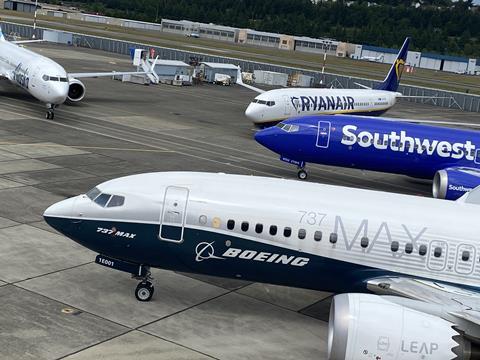Boeing has received an exemption allowing the Federal Aviation Administration to certificate the 737 Max 7 even though the type’s stall-management system fails to meet certain certification requirements.
The FAA on 19 September approved an exemption relating to lightning and radiation rules, but says in-service Max 7s will need an updated “stall management yaw damper” (SMYD) by 1 March 2027.
The agency’s decision allows Boeing to proceed with the Max 7’s certification without first addressing non-compliance of the type’s SMYD.

The SMYD is a critical hardware and software system that contributes data to the Max’ stall warning system. Boeing intends to develop a certification-compliant SMYD as part of its certification work on the 737 Max 10, and to roll those updates into other variants, documents say.
Boeing’s latest schedule calls for it to achieve the Max 7’s certification this year, followed by the Max 10’s next year.
“Boeing sought approval from the FAA to certify the [Max 7] with an updated stall management yaw damper based on the unit’s well-established safety record,” the company says. “Boeing has made minor software updates to the SMYD that reflect the [Max 7’s] shorter fuselage.”
The FAA initially told FlightGlobal that all Max models will eventually need the updated software – meaning Max 7s, Max 8s and Max 9s. Also, Boeing’s exemption request from June said it intended to apply the updated software to “all other 737 Max models, including the [Max 7]”.
But on 21 September the FAA changed course, saying it was incorrect in saying that Max 8s and Max 9s will also need the changes. It retracted that statement and pointed to its approval, which says: “On or before August 1, 2025, a service bulletin must be submitted for FAA approval to allow retrofit of the software update to bring the in-service fleet into compliance. The airplane may not be operated beyond March 1, 2027, unless the design change has been incorporated.”
Boeing had initially also said it did not expect models other than the Max 7 would require a SMYD update.
Boeing’s 737 Max development chief project engineer Gary Hamatani first raised the SMYD issue in a 29 June letter to the FAA.
He said Boeing had tweaked the Max 7’s SMYD software “to address model-specific updates to stall warning, stall identification schedule, yaw damper filter and schedule coefficients, and gain schedules”.
Only later did the company discover the system “was not compliant” with certification rules requiring critical components be capable of operating despite being struck by lightning or affected by radiation, Hamatani’s letter said.
He insisted the Max 7’s SMYD is still absolutely safe, saying it shares the same hardware as SMYDs on other Max and 737NG models and has only small software changes.
“Boeing affirms that the update to the… software has no impact to safety,” Hamatani told the FAA. “This exemption will facilitate the earlier entry into service of the [737 Max 7], which reduces short-term operational costs and leads to greater operational capability, benefiting the travelling public.”
Boeing proposed completing “additional certification activity” on the SMYD “as part of the [Max 10’s] certification project, saying, “The changes will then be applied to all other 737 Max models, including the [Max 7]”.
During the FAA’s review, Boeing told the agency that lightning- or radiation-induced SMYD failures could trigger “rudder oscillation”. The FAA calls that condition a “catastrophic failure” that “could trigger a hard-over condition and exceed structural limit loads “.
Still, the FAA agrees that the risk is minimal.
“The SMYD failure scenario has been assessed by Boeing as not a practical possibility,” the agency’s 19 September approval says. “The FAA concurs with this assessment.”
In addition to requiring that all 737 Max have updated SMYD by 1 March 2027, the FAA is giving Boeing until that date to incorporate the updates into its production of new-build 737 Max.
Story updated on 20 September to include confirmation from the FAA that 737 Max 8s and 9s will also need updated SMYDs by 1 March 2027. Story updated again on 21 September to reflect new information from the FAA, which told FlightGlobal it had issued incorrect information in saying other Max models would need the change. The agency retracted that statement.


























